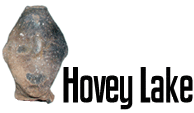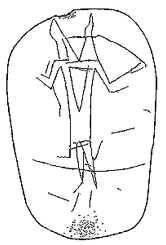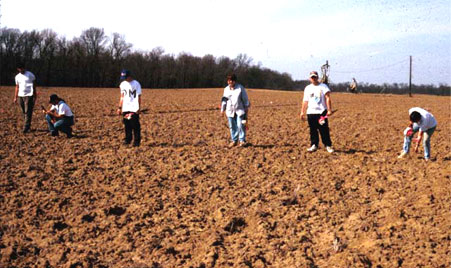 |
CURRENT
RESEARCH |
INDIANA
ARCHAEOLOGY
MONTH 2003 Calendar What is Archaeology? Exhibits Public Lecture Artifact Identification Day Excavation Open House |
| Research
at the Hovey Lake site in 2003-2005 is supported by: a grant from
the Federal Highway Administration (FHWA)
under the Enhancement Program, Indiana
University, and private contributions. The Indiana
Department of Transportation (INDOT) administers the TE grant.
Also contributing to the research project are: the Indiana State Museum, University of Southern
Indiana, University of
Evansville, Indiana State
University, and community groups and volunteers. |
Questions
or Comments?
|
Last
Updated 9.6.2003
|
Lab Focus
Cheryl Munson's research since the 1970's has concentrated on learning more about the Native American peoples and cultures of the Mississippian tradition in southwestern Indiana and adjacent states. Archaeologists recognize two distinct Mississippian cultures in this area. The Angel culture was centered around the preserved town and mound center at Angel Mounds State Historic site in Evansville. The Angel society existed for about 300 years, during the period A.D. 1050-1450, but by A.D. 1400 started to decline. About this time another Mississippian culture began to emerge from the collapse of the Angel chiefdom. This is the Caborn-Welborn culture, which lasted to about A.D.1650 or 1700. Caborn-Welborn people moved from the Angel site and Evansville region and began building their villages and hamlets near the Mouth of the Wabash River. After living there for several hundred years, they abandoned the Ohio Valley region for reasons that are not understood. Warfare with neighboring groups (perhaps the Iroquois?) and reduction of the population due to diseases introduced from Europe are two possible explanations. By the time American explorers reached the Mouth of the Wabash in the 1760s, they enountered only hunting parties of eastern Native American tribes that had been displaced from their original homelands.
Angel and Caborn-Welborn sites
Archaeologists have so far documented the location of 29 Caborn-Welborn sites in Indiana. Many more are probably present, since surveys have covered less that 10% of the homeland of the Caborn-Welborn people.
Research on the Caborn-Welborn culture includes learning about the lifestyle of these people.
Where are their settlements? How big are they? How old are the various Caborn-Welborn sites, and how long did the occupations last? What did the people eat? What kinds of plant foods did they grow? Were wild plant foods important? What animals did they hunt, trap, net, and hook? Were bison an important source of meat? Were sites located in particular environments, to take advantage of certain soils, sources of food, or access to transportation routes?
What kinds of houses and storage facilities did they build? How did they arrange their houses and other facilities? Did the people build defensive walls around their villages? What did their villages and hamlets look like? How did the people arrange their houses and other constructions? How did life in the larger villages differ from that in the smaller hamlets? How were the various communities in the region organized socially and economically? What was the nature of trade with other Native American groups? What kinds of European trade goods were acquired by Caborn-Welborn people: metal and glass ornaments, or metal tools, guns, and gun flints? Were there changes over time in Caborn-Welborn culture or society?

Engraved stone (siderite) tablet found by Jerry King
in 1964 on the surface of the Caborn site (Posey County), one of the
type sites of the Mississippian Caborn-Welborn culture (A.D. 1400-1700).
The human-like figure appears to be a hunter holding weapons. A similar
engraved figure is on the back of the tablet.
Research carried out to date
has begun to answer these questions, among others, but much remains
to be learned. Cheryl Munson's research on the Caborn-Welborn
culture has emphasized four approaches:
(1) Interviews and site reports. She records the locations where artifact collectors have found materials that could signify a Mississippian site (whether Caborn-Welborn, Angel, or another yet undefined Mississippian culture). Artifacts that are diagnostic of Mississippian cultures are triangular or small willow leaf-shaped arrow points, endscrapers, and pottery which contains fragments of mussel shell for temper. She sometimes photographs or sketches artifacts to augment the site records. These site reports provide an essential resource for advancing our knowledge about Mississippian and other cultures.
(2) Surveys. Cheryl and her research team conduct surface surveys to search out sites in areas that professionals have not previously checked. Survey work also involves documenting site size and types of artifacts, assessing the intensity of prehistoric occupation, and mapping site boundaries. More intensive survey methods are used to study large, complex sites, or to select areas that would be most amenable for test excavations. (See photos below. Also see 1997, 1998, 2000 reports by Cheryl Ann Munson, on file at the Alexandrian Public Library, Workingmen's Institute, Department of Natural Resources - Division of Historic Preservation and Archaeology, National Park Service, and Indiana University.)

Survey of a recently plowed farm field in southwestern Indiana.
(3) Test Excavations. To reconstruct Caborn-Welborn lifeways and to
interpret the social, political, and economic aspects of Caborn-Welborn
society, it is essential to compare large and small sites, and sites
of different ages. Thus archaeologists need radiocarbon dates, as well
as systematically excavated samples of artifacts, ecofacts, and construction
features, from a range of sites. It is also necessary to excavate test
samples in a variety of locations within large sites, to obtain representative
samples. So far, archaeologists have carried out test excavations in
only a few locations at large sites, but five Indiana sites are represented
by excavation samples: Leonard, Hovey Lake, Caborn, Murphy, and Bone
Bank.
Testing additional areas at large sites, like Hovey Lake and Murphy,
and testing other smaller sites, like Caborn, continue to be primary
goals. (See 1997, 1998, 2000 reports of test excavations by Cheryl Ann
Munson on file at the Alexandrian Public Library, Workingmen's Institute,
Department of Natural Resources - Division of Historic Preservation and
Archaeology, National Park Service, and Indiana University.)
(4) Mitigative
Excavations. Prior to modern constructions, archaeologists
have excavated impact areas at several Caborn-Welborn sites, in order
to learn as much as possible about areas of significance. Archaeologists
also excavated the many disturbed areas at the Slack Farm site near Uniontown,
Kentucky, after this large Caborn-Welborn village and its cemeteries
had been greatly damaged by looters. The looters dug into more than 1,000
burials and hundreds of village features. Archaeologists and volunteer
workers collected artifacts and radiocarbon samples from village refuse
deposits and documented the looter's impacts. (See: Slack Farm and the
Caborn-Welborn People, by David Pollack, Cheryl Ann Munson, and A. Gwynn
Henderson, Kentucky Archaeological Survey, Education Series No. 1, Lexington,
1996; see also Cheryl Munson's 1998 report.)
Public Education / Indiana Archaeology Month
Numerous co-sponsors from Posey County and southwestern Indiana have joined with Indiana University and the Indiana Department of Natural Resources to present a program that allows the general public to see and learn about archaeology. There have been exhibits, a public lecture, a booklet about the Hovey Lake site, an artifact identification day, and field trips for 4th graders to Indiana University's ongoing research at the Hovey Lake site. The annual education program culminates with an Excavation Open House for people of all ages.
Thanks to the Indiana Humanities Council, Indiana University was awarded funds in 1999 for Cheryl to produce a video of our 4th grade lessons in archaeology, including the field trip. The videography was done by the University of Southern Indiana. Next year, teachers throughout Indiana and other states may rent the video, as well as hands-on Archaeology Learning Kits, through USI's Distance Learning Network.

